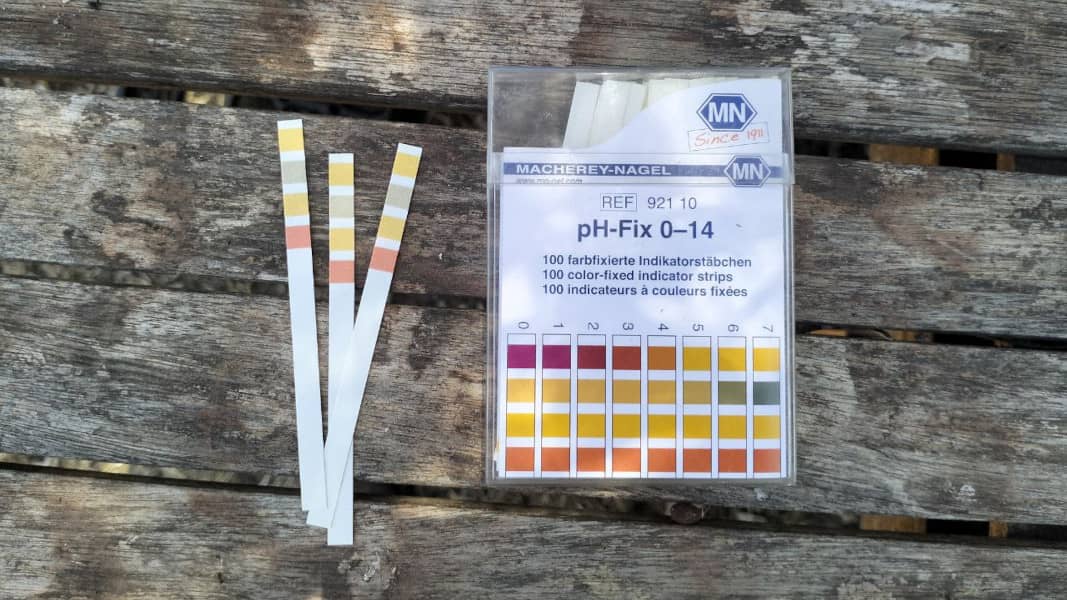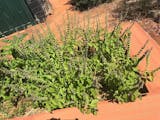A hydrogen ion is, strictly speaking, the nucleus of a hydrogen atom separated from its accompanying electron. The hydrogen nucleus consists of a particle that carries a positive electrical charge: the proton, represented by the symbol H+.
<tc>pH value - fundamentally crucial in gardening for soil and plant health</tc>

Table of contents
History – pH Basics
Background knowledge - Why the pH value is crucial
Tip
Test the soil pH
Notice
How can the pH value be changed?
Raise pH value (alkaline)
- Kalk
- Holzasche
- Natron
Reduce pH value (acidic)
- Kaffeesatz
- Organisches Material
- Traubentrester
Indicator plants - they show us the pH value in the soil
- Blueberry [Vaccinium myrtillus]
- Heather [Calluna vulgaris]
- Lingonberry [Vaccinium vitis-idaea]
- Sundew [Drosera]
- Golden-Chamomile [Cota]
- Small Sorrel [Rumex acetosella]
- Calluna [Calluna vulgaris]
- Oxeye Daisy [Leucanthemum vulgare]
- Lawn Daisy [Bellis perennis]
- Yorkshire Fog [Holcus lanatus]
- Wild Mint [Mentha arvensis]
- Arnica [Arnica]
- Matgrass [Nardus stricta]
- Oxalis [Oxalis]
- Fire weed [Chamaenerion angustifolium]
- Kiwi [Actinidia deliciosa]
Plant indicators for alkaline soils
- Charlock [Sinapis arvensis]
- Birdseye Speedwell [Veronica chamaedrys]
- Kidneyvetch [Anthyllis vulneraria]
- Nodding plumeless-thistle [Carduus nutans]
- Forking Larkspur [Consolida regalis]
- Common chicory [Cichorium intybus]
- Meadow Sage [Salvia pratensis]
- Lavender [Lavandula angustifolia]
The color of red plants such as red cabbage is also suitable for roughly determining the pH value. In very acidic soils, the red of the leaves or the juice obtained turns a very deep reddish color, whereas in a more neutral soil the red turns more blue-green.
No comments











![<tc>Annual Mugwort [Artemisia annua]</tc>](http://www.benjis.net/cdn/shop/files/EinjaehrigerBeifuss-AnnualMugwort-AnnualMugwort-Artemisiaannua-www.benjis.net_533x.jpg?v=1717419150)
![Lemon Balm [Melissa officinalis]](http://www.benjis.net/cdn/shop/files/Zitronenmelisse-Lemonbalm-Erva-cidreira-Melissaofficinalis-www.benjis.net_533x.jpg?v=1708554419)
![Watercress [Nasturtium officinale]](http://www.benjis.net/cdn/shop/files/Brunnenkresse-Watercress-Nasturtiumofficinale-www.benjis.net_533x.jpg?v=1704579308)
![Catmint [Nepeta cataria]](http://www.benjis.net/cdn/shop/files/Katzenminzewww.benjis.netGESCHNITTEN_533x.jpg?v=1696771248)
![Peppermint [Mentha x piperita]](http://www.benjis.net/cdn/shop/files/Pfefferminze-Peppermint-Hortela-pimenta-Menthaxpiperita-www.benjis.net_533x.jpg?v=1709163251)
![Asian Mint Jing-Jie [Schizonepeta tenuifolia]](http://www.benjis.net/cdn/shop/files/AsiatischeMinzeJingJie-Asianmint-Mentaasiatica-Schizonepetatenuifolia-www.benjis.net_533x.jpg?v=1708818223)
![Common Tansy [Tanacetum vulgare]](http://www.benjis.net/cdn/shop/files/Rainfarnwww.benjis.net_533x.jpg?v=1697125811)
![Borage [Borago officinalis]](http://www.benjis.net/cdn/shop/files/Borretsch-Borage-Borragem-Boragoofficinalis-www.benjis.net_533x.jpg?v=1708551722)





